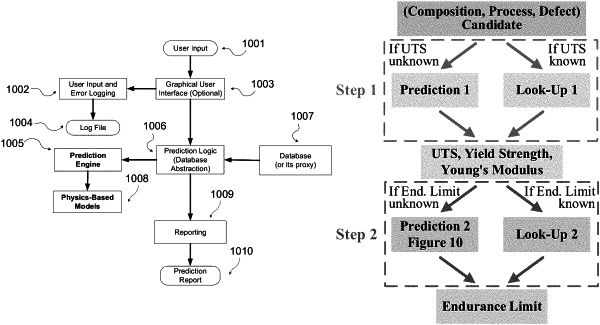| CPC G06N 20/00 (2019.01) [B22F 10/366 (2021.01); B22F 10/368 (2021.01); B22F 10/80 (2021.01); B22F 10/85 (2021.01); B22F 12/45 (2021.01); B22F 12/90 (2021.01); B29C 64/153 (2017.08); B29C 64/268 (2017.08); B29C 64/393 (2017.08); B33Y 50/02 (2014.12); G06F 18/211 (2023.01); G06F 18/213 (2023.01); G06F 30/27 (2020.01); G06N 7/01 (2023.01); G16C 20/30 (2019.02); G16C 20/70 (2019.02); G16C 60/00 (2019.02); B22F 10/22 (2021.01); B22F 10/25 (2021.01); B22F 10/28 (2021.01); B22F 10/36 (2021.01); B33Y 10/00 (2014.12); B33Y 30/00 (2014.12); B33Y 70/10 (2020.01); G06F 2113/10 (2020.01); G06F 2119/08 (2020.01)] | 21 Claims |

|
1. An apparatus for predictive analytics, an apparatus that employs a prediction module, for the purpose of efficiently searching composition space of alloys or composites of interest, and hence for accelerating design or manufacturing of alloys or composites with desired material characteristics, an apparatus comprising of
a database importing module, for ingesting materials or manufacturing data,
an optional data base abstraction module, also referred to as prediction logic, for abstracting the interface between the prediction module and the database,
an optional preprocessing module, for unified comparison of materials or manufacturing data across data sets,
an optional feature selection module, for extracting features that best describe the material or manufacturing data of interest,
a prediction module, also referred to as a prediction engine, for predicting material properties or manufacturing parameters of interest, along with a corresponding composition or composition range, given the materials or manufacturing data ingested, where the prediction engine employs a prediction technique, where the prediction engine combines physics-based models, or analytical models, specific to the alloys or composites of interest, with traditional black-box prediction models, for improved prediction accuracy, and where the prediction technique employed can involve regression analysis, with relatively few unknown model parameters, when limited data is available, but a machine learning predictor, with relatively many unknown model parameters, when sufficiently large data set is available, where the prediction technique is selected such that at least one data point is available for each unknown prediction model parameter, and
an optional reporting and verification module, for reporting, evaluating or verifying the materials properties or manufacturing parameters estimated,
an apparatus presented either in the form of an integrated or an embedded application.
|